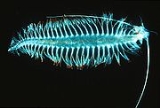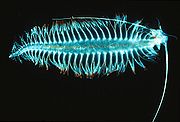
Parapodium
Encyclopedia
Parapodia singular parapodium, are paired, un-jointed lateral outgrowths from the bodies of two different invertebrate
groups, which are primarily marine in habitat. These structures are characteristic of Polychaeta, and several clade
s of sea snail
s and sea slug
s.
 Parapodia in polychaetes are either uniramous or biramous. In the latter case, the dorsal
Parapodia in polychaetes are either uniramous or biramous. In the latter case, the dorsal
lobes or branches are called notopodia and the ventral branches neuropodia.
Both neuropodia and notopodia can bear cirri (called respectively neurocirri and notocirri) and seta
e (called respectively neurosetae and notosetae). The cirri between the two branches are called interramal cirri.
are also called parapodia (they are particularly well-developed in sea butterflies). Some sea hares also use their parapodia to swim. Parapodia can be used for respiration (such as gills) also they can be used for locomotion.
Parapodia are found in:
Invertebrate
An invertebrate is an animal without a backbone. The group includes 97% of all animal species – all animals except those in the chordate subphylum Vertebrata .Invertebrates form a paraphyletic group...
groups, which are primarily marine in habitat. These structures are characteristic of Polychaeta, and several clade
Clade
A clade is a group consisting of a species and all its descendants. In the terms of biological systematics, a clade is a single "branch" on the "tree of life". The idea that such a "natural group" of organisms should be grouped together and given a taxonomic name is central to biological...
s of sea snail
Snail
Snail is a common name applied to most of the members of the molluscan class Gastropoda that have coiled shells in the adult stage. When the word is used in its most general sense, it includes sea snails, land snails and freshwater snails. The word snail without any qualifier is however more often...
s and sea slug
Slug
Slug is a common name that is normally applied to any gastropod mollusc that lacks a shell, has a very reduced shell, or has a small internal shell...
s.
In polychaete worms

Dorsum (biology)
In anatomy, the dorsum is the upper side of animals that typically run, fly, or swim in a horizontal position, and the back side of animals that walk upright. In vertebrates the dorsum contains the backbone. The term dorsal refers to anatomical structures that are either situated toward or grow...
lobes or branches are called notopodia and the ventral branches neuropodia.
Both neuropodia and notopodia can bear cirri (called respectively neurocirri and notocirri) and seta
Seta
Seta is a biological term derived from the Latin word for "bristle". It refers to a number of different bristle- or hair-like structures on living organisms.-Animal setae:In zoology, most "setae" occur in invertebrates....
e (called respectively neurosetae and notosetae). The cirri between the two branches are called interramal cirri.
In opisthobranch gastropod mollusks
The fleshy protrusions on the sides of some snailsGastropoda
The Gastropoda or gastropods, more commonly known as snails and slugs, are a large taxonomic class within the phylum Mollusca. The class Gastropoda includes snails and slugs of all kinds and all sizes from microscopic to quite large...
are also called parapodia (they are particularly well-developed in sea butterflies). Some sea hares also use their parapodia to swim. Parapodia can be used for respiration (such as gills) also they can be used for locomotion.
Parapodia are found in:
- Clade CephalaspideaCephalaspideaThe suborder Cephalaspidea, also known as the headshield slugs and bubble snails, is a clade of sea slugs and bubble snails, marine gastropod mollusks within the larger clade Euopisthobranchia....
- Clade Thecosomata
- Clade Gymnosomata
- Clade Aplysiomorpha

